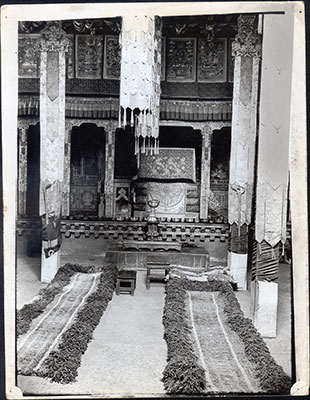
1998.131.330 (Print black & white)


1998.131.330 (Print black & white)

Frederick Spencer Chapman
Frederick Spencer Chapman
December 24th 1936?
Lhasa > Norbu Lingka > Throne room
1998.131.330
230 x 178
Print gelatin silver
Donated 1994
Faith Spencer Chapman
British Diplomatic Mission to Lhasa 1936-37
Frederick Spencer Chapman
C.20.7 [view film roll]
SC.T.2.330
BMR.86.1.4.1
Notes on print/mount - There are a large number of crop marks and other annotations on the back of the print, written in pencil. The reference number 'C-20-7' has also been written across the middle of the print on the back [MS 20/03/2006]
Manual Catalogues - Caption in Chapman's hand-written list of negatives made whilst on the Mission to Lhasa, 1936-7 [See PRM Manuscripts Collection]: 'Norbhu [Norbu] Lingka int. 2 rugs on ground v. [vertical]'; PRM Manuscripts Collection: ‘List of Tibetan Prints and Negatives’ - Book 2: ‘10/1 - Dalai Lama’s throne in assembly room in Norbhu Lingka palace. Notice thankas on wall’ [MS 20/03/2006]
Contemporary Publication - This image was reproduced in Chapman's book Lhasa the Holy City , with the caption 'Dalai Lama's throne in reception room at Norbhu Lingka' [London: Chatto & Windus, 1938, facing p. 184] [MS 20/03/2006]
Exhibition - This image appeared in the 2003 Temporary Exhibition at the Pitt Rivers "Seeing Lhasa: British Depictions of the Tibetan Capital 1936-1947"
Other Information - Description: "The Dalai Lama's reception room is magnificently decorated. The throne, on which he used to sit cross-legged, is about six feet higher than the polished floor. Over the front of it hangs a wonderful piece of embroidery showing the swastika and sacred thunderbolt (dorje) symbols. On each side are pillars swathed in heavy silk hangings. A row of richly coloured thankas framed in brocade hangs along the back wall. The roof beams and the capitals of the pillars are especially beautifully decorated with gold and bright-coloured flower patterns" ['Lhasa: The Holy City', F. Spencer Chapman, London: Chatto & Windus, 1938, p. 184]
Other Information - Related Images: Both 1998.131.325 [C.20.9] and 1998.131.330 [C.20.7] appear to have been taken on the same day. However, in one carpets have been placed on the floor in front of the throne and in the other they are absent [MS 20/03/2006]
Other Information - Historical Background: The Dalai Lama’s throne in an assembly chamber at the Chensek Potrang, one of the palaces built by the 13th Dalai Lama at the Norbhu Lingka. The building was erected at the end of the 19th century [CH 2003]
Other Information - Related Images: Images prefixed with 'C.20' comprise a group of images taken at a ceremony at the Jokhang and in the Norbu Lingka. The images from the Jokhang are not in the PRM collection, but it is possible to date these to December 24th 1936. It seems likely that Chapman may have made a visit to the Norbu Lingka on the same day to take some further images of the interior there. They seem almost certainly to have been taken in the week before January 1937 [MS 18/03/2006]
For Citation use:
The Tibet Album.
"Throne room, Norbu Lingka"
05 Dec. 2006. The Pitt Rivers Museum.
<http://tibet.prm.ox.ac.uk/photo_1998.131.330.html>.
For more information about photographic usage or to order prints, please visit the The Pitt Rivers Museum.
© The Pitt Rivers Museum